Rising Inflation Expectations Amidst An Inflationary Storm :2008-2009
Economics / Inflation Oct 03, 2007 - 12:28 AM GMTBy: Jordan_Roy_Byrne

 The average person isn't concerned yet about inflation. They have witnessed and experienced rising costs in food, energy, healthcare and tuition while the government and media consistently proclaim inflation to be low and well contained. Do these people have an ounce of decency? The roots of their corrupt and deceitful behavior can be traced back to a fiat monetary system that operates on debt and inflation, which is a form of counterfeiting. Joe Sixpack knows all this isn't right. But he doesn't know the true cause of rising prices in everyday living expenses, nor does he believe things are unmanageable. At least not yet. To date the Fed has succeeded in obfuscating inflation to the public. They have kept inflation expectations low enough. Though once the public wises up, their confidence game is lost.
The average person isn't concerned yet about inflation. They have witnessed and experienced rising costs in food, energy, healthcare and tuition while the government and media consistently proclaim inflation to be low and well contained. Do these people have an ounce of decency? The roots of their corrupt and deceitful behavior can be traced back to a fiat monetary system that operates on debt and inflation, which is a form of counterfeiting. Joe Sixpack knows all this isn't right. But he doesn't know the true cause of rising prices in everyday living expenses, nor does he believe things are unmanageable. At least not yet. To date the Fed has succeeded in obfuscating inflation to the public. They have kept inflation expectations low enough. Though once the public wises up, their confidence game is lost.
Last week the Fed faced, for the first time, the awaited problem. A handful of distinguished analysts have observed that the Fed was ultimately between a rock and a hard place. Their oversight of epic credit and monetary expansion since 1971, would lead to either deflation (massive contraction in credit and money) or continued inflation. In the words of the great Austrian economist, Ludwig von Mises:
"There is no means of avoiding the final collapse of a boom brought about by credit expansion. The alternative is only whether the crisis should come sooner as a result of a voluntary abandonment of further credit expansion, or later as a final and total catastrophe of the currency system involved. ”
While it is the Fed's foremost job to “take away the punch bowl” and protect the currency, the reality is one of epic deflationary forces (credit debt, leverage, derivatives) that threaten the entire world financial system. Thus, the Fed and other central banks have to continue to inflate to maintain stability in the markets and economy. Given that today's deflationary forces are greater than those of 2001, 1998, 1990 and 1987, the inflationary medicine (to ward off deflation) has to be stronger and more painful.
Last Tuesday, the Fed began the next great inflation with a ½ point rate cut. Unlike past inflations, this round will increase and exacerbate inflation expectations, which have been non existent for almost 30 years. Let's take a look at some forms or symptoms of inflation and how they will precipitate rising inflation expectations.
Monetary Inflation
This is the classical definition of inflation, which, over time has been neglected and lost to a definition of “rising prices.” Inflation is an increase in the supply of money or currency in circulation. Monetary is an adjective as it helps specify inflation, since today's perception is that inflation is related to prices. Monetary inflation is what causes all other forms of inflation. The following graph from economagic.com shows M3 money supply growth (at an annualized rate) until March 2006 when the Federal Reserve discontinued reporting of it.
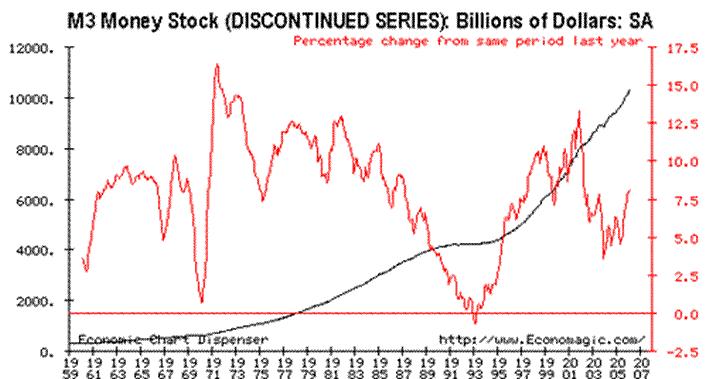
Nowandfutures.com has reconstructed M3.
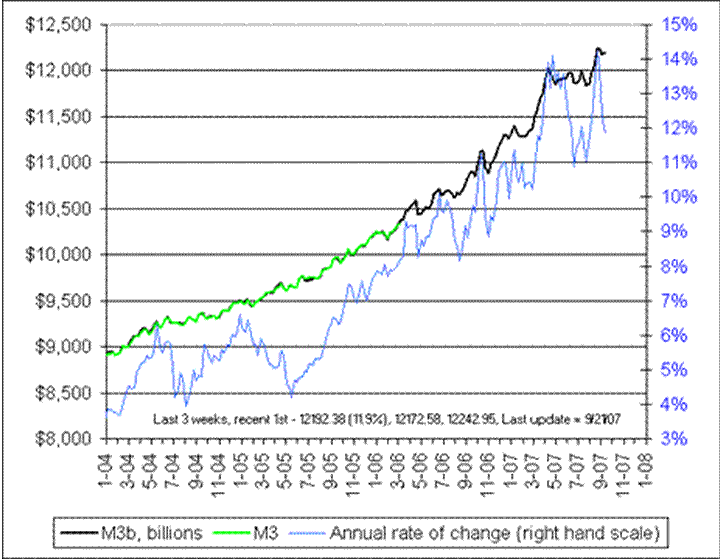
Since the Fed discontinued its reporting in March of 2006, M3 annualized growth has soared from 8% in to as high as 14% this year. Except for 1971 and the abandonment of the gold standard, that is as high as monetary growth has been in the post World War II era. The public is far more likely to notice inflation in its symptoms, rather than its cause. Still, perceptive citizens who understand inflation, are aware that inflation, by its real definition, is set to hit levels not seen since World War II and World War I. There remains only one generation left (those born prior to and during the Depression) that can truly understand and explain what lies ahead.
Commodity Inflation
Since 2001, we have seen a major bull market in all commodities. While all commodities generally move together, if we zoom in, we can see that different groups have led at different times. This, in part, has helped to downplay the relationship between inflation and commodity prices.
For most, the first commodity that comes to mind is oil. Oil's gains, and those of natural gas were most acute in 2004 and 2005. Pundits said it was only temporary. If it wasn't evidence of inflation, it was evidence of a strong economy. The metals led in 2005 and 2006. The significant rise seen in metals such as copper, zinc, and nickel was seen as evidence of a strong global economy. Amazingly, this same explanation was used to downplay the rise in gold. The thinking was that gold was rising due to Asian and Indian jewelry demand. It had little to do with rampant money and credit inflation. Since 2006 it has been the agricultural or the soft commodities that have led. The Dow Jones Agriculture Spot Index is up roughly 55% in the past 12 months and up 38% in the past five months. The weather is a common explanation.
Many lose sight of the fact that not only are all commodities priced in dollars but also that monetary inflation creates more demand (be it artificial) for everything (stocks, real estate, consumer goods, commodities). Some on CNBC will say, “the Fed can't do anything about high commodity prices.” Yes they can. They can tighten the money supply and in turn reduce demand.
In the wake of the Fed's decision we saw new highs in oil, gold and a plethora of agriculture commodities including wheat. As opposed to as recently as last year, it is now difficult to ignore the impact of inflation on all commodity prices. Going forward, energy commodities, soft commodities and the metals are set to hit new highs together. This will certainly raise inflation expectations.
Currency Inflation
This could also be called foreign exchange inflation. This occurs when a nation's currency falls (in relation to foreign currencies) and the effect is significantly rising prices of imported goods. We, as Americans, have been fortunate that China and Japan, two of the largest importers to America, have maintained artificially weak currencies. If the pace of the dollar's fall grows more acute, it will substantially raise the prices of all foreign goods and services. Since we import much of what we need, it will be very noticeable to consumers. What is also noticeable is that the dollar has broken through substantial long term support and has hit an all time low .
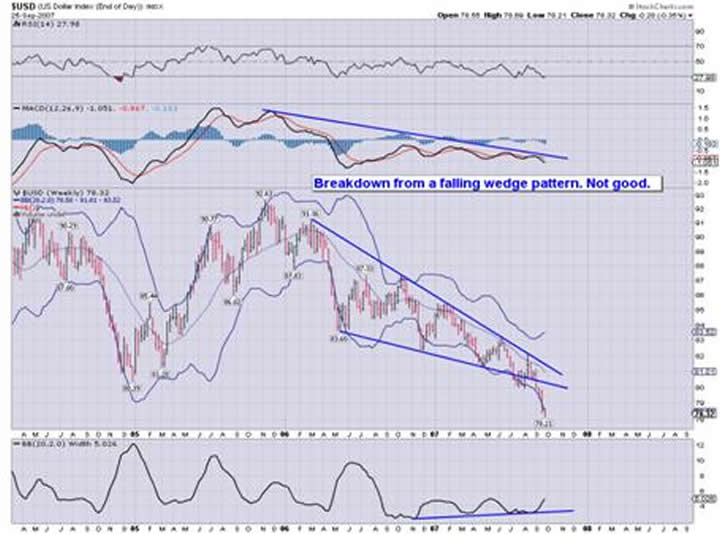
The greenback has broken down from a, normally bullish, falling wedge pattern. Typically this type of breakdown is severe as downside momentum explodes. The dollar has already broken below huge long term support at 80. Bollinger Band width is telling us that volatility is soon to pickup. MACD is in position for downside momentum to increase. After support at 72, 40 becomes the next target. You think inflation expectations might rise soon given this picture?
Wage Inflation
This occurred in the 1970s. This isn't so much of a problem now in the US because corporations can go offshore. True free market capitalism is deflationary as more workers, more efficiency and more production leads to falling prices. The problem for workers today is that competition and opportunities are increasing but at a time when most governments and central banks are flooding the world economy with excess money and credit. Dwindling job security for workers in the US makes it difficult to demand higher wages.
However, workers in China (the new engine of global growth) have more clout. Inflation just hit an 11 year high in China . For workers to keep pace, wages will have to rise. In the past 10 years, we have been fortunate to export inflation (send money overseas) and import price deflation in the form of cheaper foreign made goods. Rising wages in China and other Asian countries will raise the prices of imported goods.
Current Inflation Expectations
While commodity investments have appreciated tremendously in the past five years, so have world stock markets. If inflation expectations had been rising, then we would see more of a disconnect (between real assets and paper assets) instead of a tight correlation.
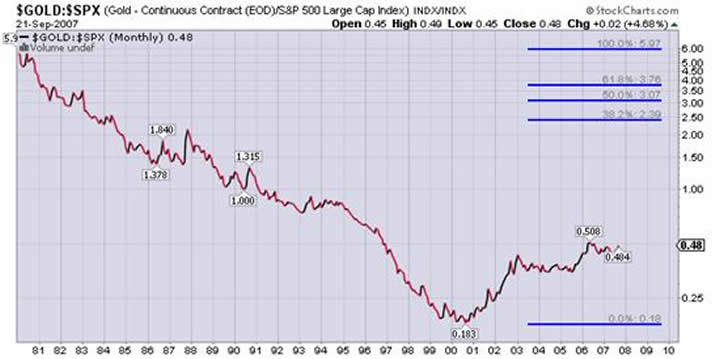
Since 2000, Gold has outperformed the S&P 500, but it is not even close to retracing 38% of its losses from 1980 to 2000. When inflation expectations rise, you will see this ratio soar as more money abandons financial assets for the safety of gold. Another sign of low inflation expectations is the ratio of gold stocks to the price of gold. Posted below is a long-term chart of the XAU index divided by gold. At the bottom we see the gold price.
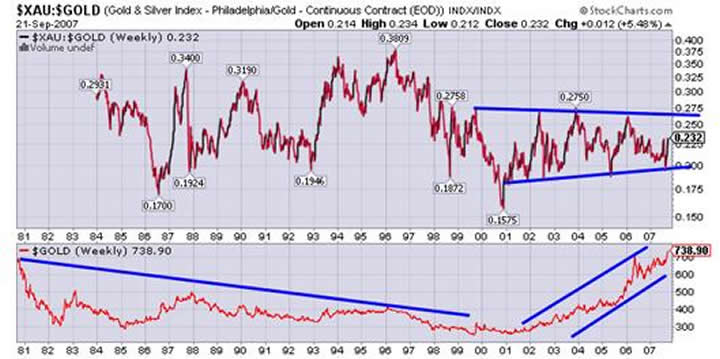
The gold stocks, despite gold rising from $250/ oz to $730/oz, have remained in a range when compared to gold. This range is actually lower than the 1980-2000 range, in which gold was in a bear market. You would expect the gold stocks to not only outperform gold in the current environment, but at least be valued higher than they were in the 1980s and 1990s. This is simply a case of low or absent inflation expectations.
Conclusion
The Federal Reserve's ½ point rate cut triggered a 27 year high in the price of gold, and all time highs in Oil and Wheat, to name a few other things. Amazingly expectations of inflation are foolishly absent. The dollar just hit an all time low. Foreign currencies are hitting all time highs. Monetary inflation is at a multi decade high. Commodity prices are at multi decade highs. Inflation? Anyone? Bueller?
The lack of inflation expectations should tell you that the commodity bull market and specifically the bull market in gold, has barely scratched the surface. It is my belief that the Fed's recent cut is the wake up call that will finally stimulate rising inflation expectations. Moreover, the public awakening towards inflation is coming at a time when monetary inflation, commodity inflation, currency inflation and wage inflation, already at significant highs, are set to rise even further. The key levels to watch are $1,020/oz on gold and 72 on the US Dollar. While the inflation trend has begun to accelerate, it will turn violent if, and when those levels are broken. Good luck and protect yourself!
For more fundamental and technical analysis on the gold, stock and commodity market, you can sign up for my free newsletter on the newsletter page of my website.
By Jordan Roy-Byrne
trendsman@trendsman.com
Editor of Trendsman Newsletter
http://trendsman.com
Trendsman” is an affiliate member of the Market Technicians Association (MTA) and is enrolled in their CMT Program, which certifies professionals in the field of technical analysis. He will be taking the final exam in Spring 07. Trendsman focuses on technical analysis but analyzes fundamentals and investor psychology in tandem with the charts. He credits his success to an immense love of the markets and an insatiable thirst for knowledge and profits.
Jordan Roy-Byrne Archive |
© 2005-2022 http://www.MarketOracle.co.uk - The Market Oracle is a FREE Daily Financial Markets Analysis & Forecasting online publication.
Comments
|
anne
22 Jan 08, 07:51 |
Gold $1000 ?
thank you for the article. but i want to know when gold will reach $1000, will it happen this year? what about copper? is it going to go up after chinese new year? |


